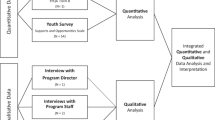Abstract
During the 1960s, there emerged a youth culture which had two major orientations: the Counterculture and the Movement. We are well informed about this youth culture, its social values, social norms, and emergent social roles (e.g., “hippie”, “freak”, “radical”, “dropout”). Part of these social and political movements was the creation of “alternative”, “counterculture”, or “radical” human service programs. Early examples were free medical clinics, drop-in centers, and telephone hotlines. Among the actual differences in these programs compared to older, “established” human service agencies was (is) the prominent position of the social value of client anonymity. This notion of client anonymity is examined in the attempt to understand its role in the relations among themes of the Counterculture, individual youth, their peers, and youth-serving agencies.
Similar content being viewed by others
References
Aronson, S. H. (1971). The sociology of the telephone.Internat. J. Comp. Sociol. 12: 153–167.
Baizerman, M., and Ellison, D. L. (1971). A social role analysis of senility.Gerontologist 11(2): 164–170.
Ball, D. W. (1968). Toward a sociology of telephones, in Truzzi, M. (ed.),Sociology and Everyday Life, Prentice-Hall, Englewood Cliffs, N. J., pp. 59–75.
Berger, P. L., Berger, B., and Kellner, H. (1973). Demodernizing consciousness.Social Policy 3(6): 3–10.
Black's Law Dictionary, 4th ed. (1957). West Publishing Co., St. Paul, Minn.
Brockopp, G. W. (1970). The telephone call—Conversation or therapy and crisis intervention.Crisis Intervention 2(3): 1–4.
Carney, R. E. (ed.) (1971).Risk-Taking Behavior, Thomas, Springfield, Ill.
Chwast, J. (1964). The social function of guilt.Social Work 9(2): 58–63.
Clark, T., and Jaffe, D. T. (1973).Toward a Radical Therapy: Alternative Services for Personal and Social Change, Gordon and Breach, New York.
Crisis Intervention (all issues). Suicide Prevention and Crisis Service, Buffalo, N.Y.
Cumming, E. (1968).Systems of Social Regulation, Atherton, New York.
Edelman, M. (1971).Politics as Symbolic Action, Markham, Chicago.
Erikson E. (1971). Youth and the Life cycle. In Muuss, R. E. (ed.),Adolescent Behavior and Society, Random House, New York, pp. 253–264.
Evan, W. (1969). The organization-set. In Thompson, J. D., and Broom, V. H. (eds.),Organizational Design and Research, University of Pittsburgh Press, Pittsburgh, pp. 175–191.
Flacks, R. (1971).Youth and Social Change, Markham, Chicago.
Goffman, E. (1959).The Presentation of Self in Everyday Life, Doubleday Anchor Books, New York.
Hasenfeld, Y. (1972). People-processing organizations: An exchange approach,Am. Sociol. Rev. 37(3): 256–263.
Hedin, D. (1972). Hotline operators look at hotlines.Center Quarterly Focus 1(3). Center for Youth Development and Research, University of Minnesota.
Hofstadter, R. (1965).The Paranoid Style in American Politics and Other Essays, Knopf, New York.
Hotlines for Youth (1972). U.S. DHEW, Youth Development and Delinquency Prevention Program, Publication No. DHEW-SRS 72-26006.
Humphreys, L. (1970). Tearoom trade: Impersonal sex in public placesTransaction 7(3): 10–25.
Jones, C., Dahlke, A. E., and La Charite, N. (1973).Helping Behavior in a Hotline Setting (mimeo, first draft), American Institutes for Research, Kensington, Md., p. 103.
Jourard, S. M. (1971).Self-Disclosure, Wiley, New York.
Kirby, D. (1971). A counter-culture explanation of student activism.Soc. Problems 19(2): 203–216.
Kogan, N., and Wallach, M. A. (1967). Risk taking as a function of the situation, the person and the group. InNew Directions in Psychology III, Holt, Rinehart and Winston, New York, pp. 111–278.
Konopka, G. (1973). Requirements for healthy development of adolescent youth.Adolescence 8(31): 291–316.
Lefton, M., and Rosengren, W. (eds.) (1970).Organizations and Clients, Merrill, Columbus, O.
Life, June 23, 1972, pp. 31–39.
MacLeod, G. (1967). Confession and absolution. In Mowrer, O. H. (ed.),Morality and Mental Health, Rand McNally, Chicago.
Merton, R. K. (1957).Social Theory and Social Structure, Free Press, Glencoe, Ill.
Moore, W. E., and Tumin, M. M. (1949). Some social functions of ignorance.Am. Sociol. Rev. 14(6): 787–795.
Natanson, M. (1970).The Journeying Self, Addison-Wesley, Reading, Mass.
National Directory of Hotlines, Switchboards and Related Services, (1972). The Exchange, 311 Cedar Ave. S., Minneapolis, Minn.
O'Rourke, D. (1973). Models for the confession.Priest 29(2): 46–54.
Oxford English Dictionary (1928). Clarendon, Oxford.
Phillips, D. L. (1969). Rejection: A possible consequence of seeking help for mental disorders. In Rusing, W. A. (ed.),Deviant Behavior and Social Process, Rand McNally, Chicago, pp. 394–401.
Rogers, E. M. (1962).Diffusion of Innovations, Free Press, New York.
Roszak, T. (1969).The Making of a Counter Culture, Doubleday, New York.
Sacks, H. (1972). The search for help: No one to turn to. In Shneidman, E. S. (ed.),Essays in Self-Destruction, Science House, New York, pp. 203–223.
Scheff, T. J. (1968). Negotiating reality: Notes on power in the assessment of responsibility.Soc. Problems 16(1): 3–17.
Schegloff, E. A. (1968). Sequencing in conversational openings.Am. Anthropologist 70: 1075–1095.
Simmel, G. (1950). The stranger. In Wolff, K. H. (ed.),The Sociology of Georg Simmel, Free Press, Glencoe, Ill., pp. 402–408.
Smith, D. E., Bental, D. J., and Schwartz, J. L. (eds.) (1971).The Free Clinic: A Community Approach to Health Care and Drug Abuse, Stash Press, Beloit, Wis.
Taber, M., Quay, H. C., Mark, H., and Nealey, V. (1969). Disease ideology and mental health research.Soc. Problems 16(3): 349–357.
Transaction/Society (special issue 1972). New life styles for Americans. 9(4).
Author information
Authors and Affiliations
Additional information
Holds degrees in social work and public health and is currently completing a report of a national survey of hotlines and youth crisis programs and working with others in editing papers for a monograph from a conference on evaluating hotlines. The survey data will appear in that publication.
Rights and permissions
About this article
Cite this article
Baizerman, M. Toward analysis of the relations among the youth counterculture, telephone hotlines, and anonymity. J Youth Adolescence 3, 293–306 (1974). https://doi.org/10.1007/BF02214743
Received:
Issue Date:
DOI: https://doi.org/10.1007/BF02214743




